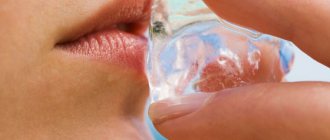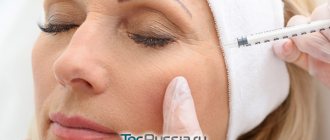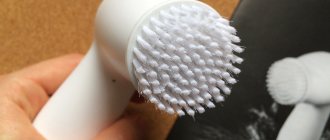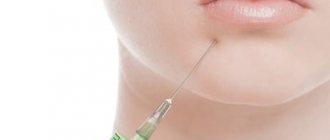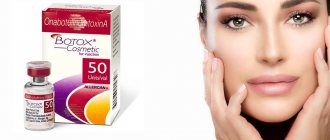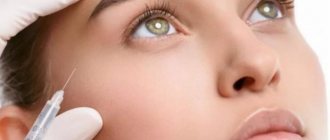From this article you will learn:
- why there is no effect after Botox injection,
- how they cheat in beauty salons.
I’m afraid that my colleagues who work in beauty salons and mostly illegally administer botulinum toxin injections will not like this article. And in 95% of beauty salons they do this illegally. This article is a must-read for those who are just about to undergo Botox, Dysport or any other botulinum toxin for the first time, and will save you from disappointment and complications.
It will also be useful for those who have already received botulinum toxin injections several times. You will find out why many patients complain that after yet another visit to a beauty salon, Botox suddenly “doesn’t work” for them (although the procedure had always been effective before). Or why the duration of the effect after injections was only 1-3 months - while the cosmetologist promised you 5-6 months. In response to complaints, any cosmetologist always says that he did everything correctly, and the reason is not in him, but in your body. But this is not true.
Resistance to Botox injections
The method is evolving. Some problems are being solved (for example, today soft correction can be provided without the effect of a “frozen” face), other imperatives, say, the possibility of working with the lower third of the face, are in the focus of attention.
Recently, the issue of resistance, or insensitivity,
to botulinum toxin injections: when the procedure is performed, but the result is absent or assessed as unsatisfactory.
There is a distinction between primary
(there is no result when the procedure is performed for the first time in life) and
secondary
(up to a certain time botulinum therapy brought the desired effect, but then stopped) insensitivity to botulinum toxin injections. Primary failure of botulinum therapy is extremely rare, and finding out its true causes is often very difficult. Failures after previously successful correction are more common.
Conclusions -
Thus, the first thing you should do is understand which specialist you came to see and whether he has the right to perform botulinum toxin injections.
Secondly, you should be wary if the cosmetologist immediately suggested that you do botulinum toxin injections on this first visit, and not on the “Botox day”. This means that the drug has either already been diluted in advance, or the remainder of the drug will go to other gullible suckers. If the doctor took out a syringe that had already been drawn up in advance, and you did not see him drawing it from the bottle, this means that you have a re-frozen and thawed drug in front of you. Some patients, when you start telling them this, begin to very zealously defend such a specialist. It’s like nothing that the drug was diluted in advance, because Botox “got up” after that. But besides the fact that he “got up” or “didn’t get up”, there are other criteria, for example, the duration of action of the drug (24stoma.ru). In addition, this can have an impact on the development of resistance to botulinum toxins - lead to the production of so-called blocking antibodies by the immune system (and then gradually the botulinum toxins will no longer affect you at all). And lastly, this is the deliberate provision of obviously low-quality services.
As for comparing the effectiveness of different botulinum toxin preparations, as we showed above, there are many simultaneously influencing factors that patients are not even aware of. And these are not only different names of drugs and the number of units, but also the degree of dilution of the drug, the “freshness” of the solution, the correct injection technique, and, banally, the honesty of the cosmetologist.
How Botox should work: Before and After video
The main reason why Botox doesn't work
Having touched on the main reasons for the unsatisfactory effect of botulinum therapy, let us dwell on another phenomenon that is widespread and, despite the fact that we talk about it at the end of the publication, perhaps the main culprit that Botox does not work or does not work as it should. “Put at least 80% on this factor,” assures Aisulu Tokaeva.
The effectiveness and safety of botulinum toxin directly depends on the conditions of its transportation and subsequent storage. Purchasing medical products from official, trusted distributors should be an axiom for the clinic. “The supplier brings us the drugs in a special carrying bag with a temperature indicator,” our interlocutor continues. “We record everything: what drug was received and when, the series and expiration date, a note on the condition of the temperature indicator... In the cosmetology room we have a logbook for recording the temperature conditions of the refrigeration equipment.” Different drugs are stored in different ways: for example, Botox and Dysport are stored in the refrigerator at a temperature of 2–8 °C, but Xeomin is stored at room temperature, not higher than 25 °C.
And now attention: information bomb
. “Once diluted, the bottle of Botox should be used within 24 hours if stored correctly,” says our consultant. “Unused solution must be disposed of within 24 hours in accordance with biological waste disposal regulations!” (And diluted Dysport can be stored in the refrigerator for no more than 8 hours).
Thus, there is a clear chain of handling of the drug, strict regulations that must be followed. But this is in ideal theory, but in practice, far from ideal, it happens that an open bottle with a diluted drug is not disposed of for a month or longer: a certain number of units of Botox were injected into one patient, and the remaining elixir of youth will somehow be injected into another - no sacrifice to the clinic its profitability... And explaining the intricacies of storage to the client, asking to pay for the entire bottle, also does not seem commercially feasible. Hence the ineffectiveness of injections.
“Why are botulinum toxin preparations sold for one unit?” - Aisulu Tokaeva is indignant. “You won’t ask the pharmacy to sell you only part of the contents, for example, of a bottle of Chlorhexidine?” In a bottle of “Xeomin” the number of units is either 100 or 50. For “Dysport” there are 500 units or 300 units. For Botox there is only one option - 100 units. “It would be nice if they started producing bottles containing 50 units of the drug,” our expert expresses hope. “This would significantly reduce the financial burden on patients who need Botox, I would be very happy about it.”
And we will be glad if this publication makes its feasible contribution to improving the situation with aesthetic botulinum therapy, because well-informed patients encourage doctors to conduct their practice more conscientiously.
Comparison of the effectiveness of different botulinum toxins –
You can often hear from patients that, for example, Dysport or Refinex act stronger and longer, and for example Botox, Botulax, Xeomin - more gently. But other patients say the opposite. I would also like to comment on this. There are comparative clinical studies that show that 1 unit of Botox is completely identical to 1 unit of Xeomin or, for example, 1 unit of Korean Botulax. At the same time, 1 unit of Botox corresponds in strength to 2.5-3 units of Dysport.
It is also difficult to compare the effectiveness of different botulinum toxins delivered by different cosmetologists because all specialists apply slightly different amounts of units to each zone and use different dilutions of the drug. Those. There are too many factors influencing the final result. Below we will describe what may lead to differences in the perception of the effectiveness of botulinum toxins from different manufacturers.
- Number of units in the bottle - for example, if the bottle says 100 units, then in reality there will never be exactly that many units. This is due to the technological impossibility of packaging a strictly defined number of botulinum toxin molecules into bottles, and, by the way, the manufacturer never keeps silent about this. The range is usually 5 units more or less. Those. a bottle of the same drug may contain less or more botulinum toxin, which affects its final concentration in solution and effect. And then how lucky you are.
- The number of units at each point - for example, you were given 12 units of Botox at the outer corners of your eyes (on each side), i.e.
3 needle insertion points were made on each side, and 4 units were removed in each. You felt the effect after the injections for 5-6 months. The next time you went to another cosmetologist, who put 11 units on each side, but at the same time made not 3, but four injection points on each side. For example, the doctor decided to make 2 additional injection points at the outer edge of each eyebrow to raise them a little, and put 1 unit at each of them. As a result, the concentration of botulinum toxin is distributed over a larger area, and accordingly this will reduce the severity and duration of the effect.
- The degree of dilution – a lot depends on the degree of dilution.
Different cosmetologists prefer different dilutions: for example, some dilute 100 units of botulinum toxin in 1.0 ml of saline, some use 2.0 ml, and others use 2.5 ml. As a result, it turns out that the number of units you need (for example, 30 units) will be diluted with a different volume of solvent in each case. In other words, in each of these cases the syringes will contain a different volume of liquid, but each of them will contain 30 units of botulinum toxin. Why is it important? The fact is that the larger the volume of the solution, the stronger its diffusion in the tissues. For example, in the first case, at each needle insertion point, 2 units of botulinum toxin are released, which are contained in 0.05 ml of the drug. In the second case, 2 units of botulinum toxin are also released at each injection point, but in 0.1 ml of the drug. So, in the second case, the diffusion (spread) of the drug in the soft tissues will be greater, and accordingly these 2 units will be distributed over a larger area and the concentration of botulinum toxin in the muscles will be lower.
- The most important and common reasons are that the strength and duration of action of botulinum toxins will be affected by violations committed by the cosmetologist. For example, one specialist supplied you with a freshly diluted high-quality drug, and another gave you a long-diluted drug that had been stored in the refrigerator for several days or weeks, or even a re-frozen and thawed drug. Other reasons are incorrect injection technique, insufficient number of units, and incompetence of a specialist.
Expert opinion
Anna K Ovalchuk,
cosmetologist and esthetician at the Matilda beauty salon
Cosmetics with the Botox effect are, of course, not an alternative to botulinum toxin injections, but they can be used as an additional measure, a way to maintain the results of botulinum therapy.
Perhaps the only situation when such a non-invasive effect is sufficient to smooth out facial wrinkles is a very young age and not yet formed, transient wrinkles that arise as a result of emotional stress.
One of the main components of the corresponding products (these are not only creams, but also, for example, masks, which are also used in professional salon care) is argillerine. This is a biopeptide, which is a sequence of six amino acids and promotes moderate relaxation of facial muscles.
A comprehensive effect on the skin will help you get the most pronounced aesthetic result from this resource. It may include superficial peeling, deep moisturizing... That is, it is better to abandon the amateur use of botulinum-like products and seek competent assistance from a specialist.
How does Botox work?
According to the experience of cosmetologists, botulinum toxin injections as a cosmetic method for correcting wrinkles are effective and safe. And due to the fact that the result is achieved without effort on the part of the client and almost immediately, the procedure has become super popular.
The toxin does not change the structure of muscles or nerves in any way, it only blocks the neuromuscular transmission of impulses from the brain to the muscle, namely the neurotransmitter acetylcholine, which is a transmitter of nervous excitation, and the muscle relaxes. The result of the procedure is reversible, but long-term - it remains normal for several months. With an active lifestyle, which leads to an increase in blood circulation, the duration of action of the toxin is slightly reduced.
Is Botox addictive?
Cases of decreased effectiveness of botulinum toxin in cosmetology were studied back in 2003. Provided that previously performed procedures are successful, the secondary ineffectiveness of the toxin manifests itself in two ways:
- reducing the duration of the effect;
- reducing the severity of the result while maintaining the dosage.
According to observations, addiction develops due to:
- administration of significant doses of botulinum toxin - more than 250 units;
- administration of the drug in small doses, but with a short interval between injections - less than 2 weeks.
Cosmetologists note that addiction will not develop if Botox is administered no more than once every 6 months and the muscle is allowed to work in normal activity mode for at least a month, i.e. When does Botox stop working?
Factors that prolong the effect of botulinum toxin
There are also drugs that enhance the effect of botulinum toxin. For example, taking some antibiotics (aminoglycosides, macrolides, spectinomycins, polymyxins, tetracyclines) while visiting a cosmetologist for an injection can lead to an overdose: 100 units of botulinum toxin will give the effect of 150, and instead of moving facial expressions, the patient will receive a “stony forehead.”
In the United States, the drug Zytaze is commercially available to increase sensitivity to botulinum toxin. It contains zinc and phytase, but when these components are taken separately (for example, in the form of vitamins), a prolonged effect is not observed. Zitaza is not sold in Russia.
Statistics say that with age, sensitivity to botulinum toxin increases. Approximate formula: after 50-55 years, the dose is halved. This is a classic approach; in practice, everything is decided individually.
